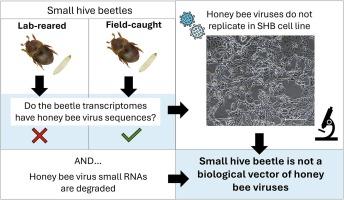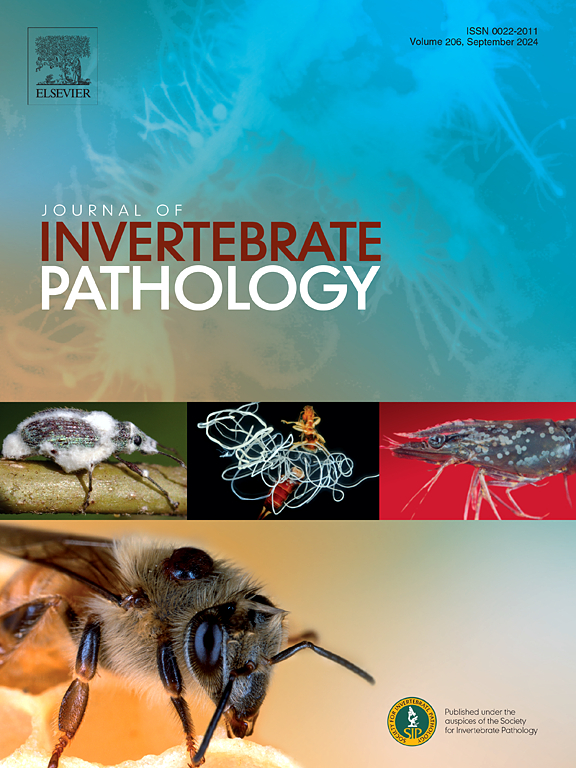Representative honey bee viruses do not replicate in the small hive beetle, Aethina tumida Murray
IF 3.6
3区 生物学
Q1 ZOOLOGY
引用次数: 0
Abstract
The small hive beetle (SHB), Aethina tumida Murray, is an invasive pest of the honey bee and causes significant damage through the consumption of colony resources and brood. Two assumptions related to honey bee virus transmission have been made about SHB: first, that SHB vectors honey bee viruses and second, that these viruses replicate in SHB based on the detection of both positive and negative strand viral genomic RNA within SHB. To clarify the role of SHB in virus transmission, we sought to address whether selected honey bee viruses replicate in SHB. Sequences derived from five honey bee viruses were identified in the transcriptomes of field-caught SHB from the U.S., but not in those of lab-reared SHB, suggesting that these viruses do not replicate in SHB. To elucidate whether the representative viruses, Israeli acute paralysis virus (IAPV; Dicistroviridae) and Deformed wing virus (DWV; Iflaviridae) replicate in SHB, we tested for replication in vitro in an SHB-derived cell line (BCIRL-AtumEN-1129-D6). Following treatment of the cell line with viral particles or viral RNA, the number of virus genomes was monitored by reverse transcription quantitative PCR (RT-qPCR). In contrast to the positive control, IAPV and DWV RNA levels steadily decreased over a period of 8 days. Collectively, these results from bioinformatic observations and in vitro experiments indicate that IAPV and DWV do not replicate in SHB. These results are consistent with the host specificity of most insect viruses within a single insect order and indicate that while SHB may serve as a mechanical vector of honey bee viruses within and between hives, this insect does not serve as a biological vector for these honey bee viruses.

具有代表性的蜜蜂病毒不会在小蜂甲虫 Aethina tumida Murray 身上复制。
小蜂巢甲虫(SHB),Aethina tumida Murray,是蜜蜂的入侵害虫,通过消耗蜂群资源和雏蜂造成重大损失。关于小蜂甲,有两个与蜜蜂病毒传播有关的假设:第一,小蜂甲传播蜜蜂病毒;第二,根据在小蜂甲体内检测到的正链和负链病毒基因组 RNA,这些病毒在小蜂甲体内复制。为了弄清SHB在病毒传播中的作用,我们试图研究选定的蜜蜂病毒是否在SHB中复制。在美国野外捕获的SHB的转录组中发现了来自五种蜜蜂病毒的序列,但在实验室饲养的SHB的转录组中没有发现,这表明这些病毒不会在SHB中复制。为了弄清以色列急性麻痹病毒(IAPV;Dicistroviridae)和畸形翅病毒(DWV;Iflaviridae)这两种代表性病毒是否会在SHB中复制,我们在SHB衍生细胞系(BCIRL-AtumEN-1129-D6)中进行了体外复制测试。用病毒颗粒或病毒 RNA 处理细胞系后,通过反转录定量 PCR(RT-qPCR)监测病毒基因组的数量。与阳性对照相比,IAPV 和 DWV RNA 水平在 8 天内稳步下降。总之,生物信息学观察和体外实验的这些结果表明,IAPV 和 DWV 不会在 SHB 中复制。这些结果与单个昆虫目中大多数昆虫病毒的宿主特异性相一致,表明虽然SHB可能是蜂巢内和蜂巢间蜜蜂病毒的机械载体,但这种昆虫并不是这些蜜蜂病毒的生物载体。
本文章由计算机程序翻译,如有差异,请以英文原文为准。
求助全文
约1分钟内获得全文
求助全文
来源期刊
CiteScore
6.10
自引率
5.90%
发文量
94
审稿时长
1 months
期刊介绍:
The Journal of Invertebrate Pathology presents original research articles and notes on the induction and pathogenesis of diseases of invertebrates, including the suppression of diseases in beneficial species, and the use of diseases in controlling undesirable species. In addition, the journal publishes the results of physiological, morphological, genetic, immunological and ecological studies as related to the etiologic agents of diseases of invertebrates.
The Journal of Invertebrate Pathology is the adopted journal of the Society for Invertebrate Pathology, and is available to SIP members at a special reduced price.

 求助内容:
求助内容: 应助结果提醒方式:
应助结果提醒方式:


